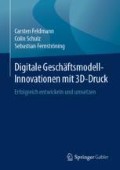Zusammenfassung
Organe, Häuser oder Pizzen – die Medien greifen gerne auf spektakuläre Anwendungsbeispiele zurück, wenn sie über den 3D-Druck (synonym: additive Fertigungsverfahren) berichten. Dabei hat der 3D-Druck seinen Ursprung nicht in menschlichen Zellen, Beton oder Tomatensoße, sondern im Bereich Kunststoff. Bereits im Jahr 1984 hat der US-Amerikaner Chuck Hull das erste Patent für das 3D-Druckverfahren Stereolithografie eingereicht.
Access this chapter
Tax calculation will be finalised at checkout
Purchases are for personal use only
Literatur
Holmström, J., Partanen, J., Tuomi, J., & Walter, M. (2010). Rapid manufacturing in the spare parts supply chain: alternative approaches to capacity deployment. Journal of Manufacturing Technology Management, 21(6), 687–697.
Winterhalter, S., Gassmann, O., & Wecht, C. (2014). Die Zukunft wird gedruckt – Aber wie wird sie verkauft? Geschäftsmodelle für die nächste industrielle Revolution. https://www.alexandria.unisg.ch/230162/1/Im%2Bio_Die%20Zukunft%20wird%20gedruckt.pdf.
Müller, A., & Karevska, S. (2016). How will 3D printing make your company the strongest link in the value chain: EY’s Global 3D printing Report 2016. Ernst & Young GmbH Wirtschaftsprüfungsgesellschaft GmbH, Germany. http://www.ey.com/Publication/vwLUAssets/ey-global-3d-printing-report-2016-full-report/$FILE/ey-global-3d-printing-report-2016-full-report.pdf.
Bromberger, J., & Kelly, R. (2017). Additive manufacturing: A long-term game changer for manufacturers. https://www.mckinsey.com/business-functions/operations/our-insights/additive-manufacturing-a-long-term-game-changer-for-manufacturers.
Hopkinson, N., Hague, R., & Dickens, P. (2006). Rapid manufacturing: An industrial revolution for the digital age. Chichester: Wiley.
Rayna, T., & Striukova, L. (2016). From rapid prototyping to home fabrication: How 3D printing is changing business model innovation. Technological Forecasting and Social Change, 48(102), 214–224.
Feldmann, C., & Gorj, A. (2017). 3D-Druck und Lean Production: Schlanke Produktionssysteme mit additiver Fertigung. Wiesbaden: Springer Gabler.
Feldmann, C., & Pumpe, A. (2016). 3D-Druck – Verfahrensauswahl und Wirtschaftlichkeit: Entscheidungsunterstützung für Unternehmen. Wiesbaden: Springer Gabler.
Author information
Authors and Affiliations
Corresponding author
Rights and permissions
Copyright information
© 2019 Springer Fachmedien Wiesbaden GmbH, ein Teil von Springer Nature
About this chapter
Cite this chapter
Feldmann, C., Schulz, C., Fernströning, S. (2019). Motivation und Ziele. In: Digitale Geschäftsmodell-Innovationen mit 3D-Druck. Springer Gabler, Wiesbaden. https://doi.org/10.1007/978-3-658-25162-8_1
Download citation
DOI: https://doi.org/10.1007/978-3-658-25162-8_1
Published:
Publisher Name: Springer Gabler, Wiesbaden
Print ISBN: 978-3-658-25161-1
Online ISBN: 978-3-658-25162-8
eBook Packages: Business and Economics (German Language)

